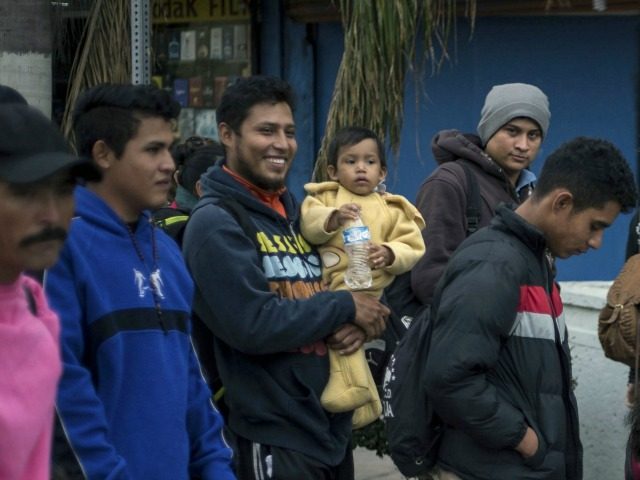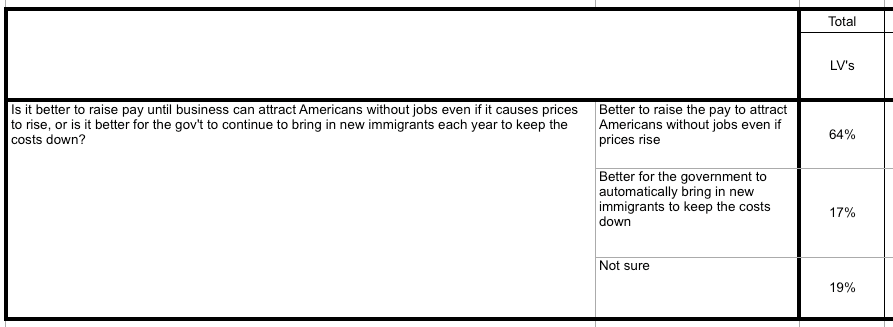A poll of likely 2018 voters shows two-to-one support for President Donald Trump’s pro-American immigration policies, and a lopsided four-to-one opposition against the cheap-labor, mass-immigration, economic policy pushed by bipartisan establishment-backed D.C. interest-groups.
The poll for NumbersUSA is another reminder to politicians that the business-funded ‘Nation of Immigrants” polls distract attention from voters’ private views, which were shockingly displayed on the evening of November 8, 2016.
The voters’ attitudes are critical as business groups, Democrats and some GOP legislators renew their push to persuade Trump to accept an amnesty of the 3 million ‘dreamer illegals — and thus drop his election-winning, pro-American policies before the 2018 election in favor of business-friendly, high-immigration/low-wage policies.
The December 19 and 20 poll of likely mid-term voters by Pulse Opinion Research asked respondents to pick from competing priorities, not just whether they want to welcome more immigrants or to declare support for the nation’s history of immigration.
That focus on priorities ensured the pollster revealed 64 percent opposition to the current wage-flattening, annual inflow of roughly 1 million legal immigrants, alongside just 17 percent support for those pro-investor, anti-employee policies. Voters were asked:
When businesses say they are having trouble finding Americans to take jobs in construction, manufacturing, hospitality and other service work, what is generally best for the country? Is it better to raise the pay until they can attract Americans without jobs even if it causes prices to rise, or is it better for the government to continue to automatically bring in new immigrants each year to keep the costs down?
The wage-raising priority got 57 percent among voters aged 18 to 39, 65 percent among blacks, 64 percent support among Latinos, 71 percent support among Republicans, 62 percent support among Democrats, but only 56 percent support among post-graduates and people who earn between $100,000 and $200,000.
According to NumbersUSA:
NumbersUSA commissioned the poll just before Christmas … The survey results are similar to what we have found in dozens of surveys throughout 2017 and earlier years in terms of voter support for eliminating Chain Migration and the Visa Lottery, mandating E-Verify, and reducing overall legal immigration.
The President’s highly visible statements on these issues appear to be neither pushing people away from his positions nor pushing them toward his positions. Instead, Trump appears to be representing the rather stable opinions of a solid majority of likely midterm voters.
The poll also showed that Hispanics are the most hostile to any increase in wage-lowering immigration — perhaps because Hispanics are most familiar with the wage-cutting impact of new arrivals.
The poll asked:
Current federal policy automatically adds about one million new legal immigrants each year giving all of them lifetime work visas. Which is closest to the number of lifetime immigrant work visas the government should be adding each year — none, 250,000, half a million, one million, one and a half million, two million, or more than two million?
Twenty-seven percent of all voters and 27 percent of Hispanics told the polls that immigration levels should be set at zero. In contrast, just 22 percent of whites said immigration should be set at zero.
More broadly, 77 percent of Hispanics preferred immigration be trimmed to 500,000 people per year, down from the 2016 score of 1.2 million legal immigrants. In comparison, 64 percent of blacks and 58 percent of whites want immigration reformed down to a half-million per year.
The same polls also showed that only 18 percent of Hispanics want annual immigration to be raised above 1.5 million a year, compared to 22 percent of whites and 12 percent of blacks who say they want immigration raised above the 1 million per year level.
Likely midterm voters say how many lifetime work visas the government should add every year (currently more than one million) https://t.co/leLDSqJYfu pic.twitter.com/Ao8Mhyq8jU
— Roy Beck (@RoyBeck_NUSA) January 3, 2018
However, the poll also shows one-in-seven Americans — and more than one-in-five blacks — said they were not sure about their answers. That caution indicates a hidden level of support for immigration cuts below the 1.2 million in 2016.
The results from the priorities poll are very different from the “Nation of Immigrants” polls pushed by business and progressive outlets. Business groups and Democrats tout the misleading, industry-funded “Nation of Immigrants” polls because they which pressure Americans to say they welcome migrants, including the roughly 700,000 ‘DACA’ illegals and the roughly 3 million ‘dreamer’ illegals.
NEW this morning – @CNN Poll: All-time high support to allow Dreamers to stay in the US: 83% support, only 13% oppose.https://t.co/DGI2xu4p7d
— Todd Schulte (@TheToddSchulte) December 19, 2017
The alternative “priority or fairness” polls — plus the 2016 election — show that voters in the polling booth put a much higher priority on helping their families, neighbors, and fellow nationals get decent jobs in a high-tech, high-immigration, low-wage economy.
Four million Americans turn 18 each year and begin looking for good jobs in the free market.
But the federal government inflates the supply of new labor by annually accepting 1 million new legal immigrants, by providing work-permits to roughly 3 million resident foreigners, and by doing little to block the employment of roughly 8 million illegal immigrants.
Support for pulling back from record immigration levels has long been under-reported but helps explain Trump's 2016 victory. https://t.co/NxbbcQcgfL
— Roy Beck (@RoyBeck_NUSA) January 3, 2018
The Washington-imposed economic policy of economic growth via mass-immigration floods the market with foreign labor, spikes profits and Wall Street values by cutting salaries for manual and skilled labor offered by blue-collar and white-collar employees. It also drives up real estate prices, widens wealth-gaps, reduces high-tech investment, increases state and local tax burdens, hurts kids’ schools and college education, pushes Americans away from high-tech careers, and sidelines at least 5 million marginalized Americans and their families, including many who are now struggling with opioid addictions.
The cheap-labor policy has also reduced investment and job creation in many interior states because the coastal cities have a surplus of imported labor. For example, almost 27 percent of zip codes in Missouri had fewer jobs or businesses in 2015 than in 2000, according to a new report by the Economic Innovation Group. In Kansas, almost 29 percent of zip codes had fewer jobs and businesses in 2015 compared to 2000, which was a two-decade period of massive cheap-labor immigration.
Because of the successful cheap-labor strategy, wages for men have remained flat since 1973, and a large percentage of the nation’s annual income has shifted to investors and away from employees.


COMMENTS
Please let us know if you're having issues with commenting.